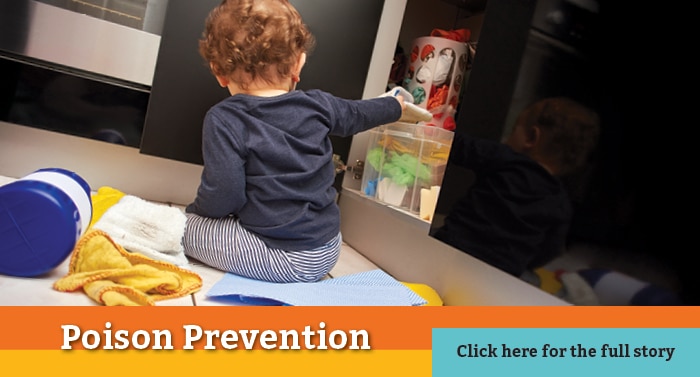By Kimberly Blaker
Poisoning is the number one cause of injury-related deaths in the U.S., according to a 2019 report by the American Association of Poison Control Centers (AAPCC). More than 2 million cases of human poison exposure in the U.S. were reported in 2017 alone. While less severe poison exposures have decreased in recent years, more serious exposures have been on the rise, according to the AAPCC annual report. Since 2000, serious cases have grown by 4.44% per year ranging from moderate severity to death.
This alarming trend reveals the importance of greater awareness of the full range of substances that pose a risk to children and adults alike. As would be expected, children under the age of 6 disproportionately account for 45% of all poisonings. Yet more serious cases of poisoning are often among teens and adults.
So be aware of these top toxins. Then take precautions to protect your children, pets, and yourself from these substances that are commonly found in the home.
TOP 5 POISON EXPOSURES
Analgesics Painkillers and fever reducers are found in nearly every home, and most people use them from time-to-time. These include aspirin, ibuprofen, and acetaminophen, among others. As a result, they’re among the top causes of poisonings.
When administering analgesics to a child, pay close attention to the recommended dosage. Also, make sure everyone in the home knows the exact time your child took the last dose to avoid the risk of an overdose. The best method to prevent such errors is to keep a written log of the time and dose given. Also, keep containers without child safety caps locked up. Of particular note, children shouldn’t take aspirin because it increases the risk for Reye Syndrome.
Analgesics can also be poisonous to pets, particularly smaller animals. So don’t give your pet analgesics without talking to your veterinarian first.
Adults can also accidentally overdose on analgesics. The risk is particularly high when combining them with cough and cold medicines because these sometimes contain ibuprofen.
Household cleaning substances These toxins result in poisoning through ingestion, inhalation, or coming in contact with the skin or eyes. The National Safety Council recommends paying close attention to the labels of all household products and following all safety precautions to protect both yourself and family members from accidental exposure.
If pets or children are in your home, keep these products stored out of reach or locked up. Use particular caution with paint, markers, glue, cleaners, and furniture and floor polish.
A danger young children are particularly vulnerable to is laundry and dishwasher packets. Infants and toddlers are attracted to these colorful little packets because they resemble teething products, candy, and toys.
Cosmetics and personal care products Most people think of these items as relatively harmless since we use them on our bodies daily. Unfortunately, children tend to use them for purposes for which they aren’t intended. Ingestion of cosmetics and personal care products can cause mild to severe reactions, including severe burns in the esophagus or mouth. Children also sometimes get these products in their eyes. This can cause severe pain or even damage.
These products can also be unsafe for adults. For example, the FDA has warned of high mercury levels found in some cosmetics manufactured overseas that are illegally sold in the U.S. Check labels for ‘mercurous chloride,’ ‘calomel,’ ‘mercury,’ ‘mercuric,’ or ‘mercurio.’ The FDA recommends immediately discontinuing the use of a product if one of these appears on the label.
Antidepressants Teens and adults are the most common victims of antidepressant poisonings. These drugs are also often the choice for suicide attempts.
But antidepressants can also result in accidental poisoning. This occurs by accidentally or even knowingly taking a dose higher than prescribed. Certain classes of antidepressants, tricyclics, in particular, can be deadly if overdose occurs. Antidepressant poisoning can also result from interaction when combined with certain medications. As with all drugs, talk to your doctor or pharmacist before combining these drugs.
Although antidepressants aren’t among the top 10 poisonings for children under 13, these drugs, like any other, can be toxic to children if not prescribed for them or if they take too high a dose.
MORE HOUSEHOLD ITEMS THAT COMMONLY RESULT IN POISONING
The following are among the most frequent exposures to poisoning within various age groups. If children or pets are in your home, make sure these hazards have child protective caps and/or are locked up and kept out of reach.
- Antihistamines
- Anticonvulsants
- Hormones & hormone antagonists
- Cardiovascular drugs
- Cough & cold medications
- Pesticides
- Alcohols
- Stimulants and street drugs
- Vitamins and supplements
- Foreign bodies – toys, etc.
- Plants
Kimberly Blaker is a freelance lifestyle writer. She’s also founder and director of KB Creative Digital Services, a niche marketing agency for the healthcare and mental health industries. Find her at kbcreativedigital.com.

